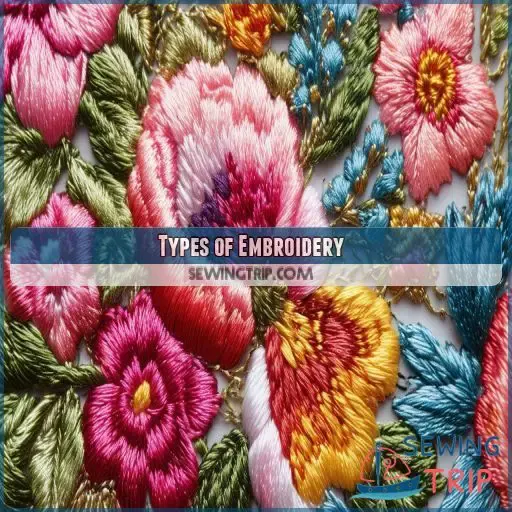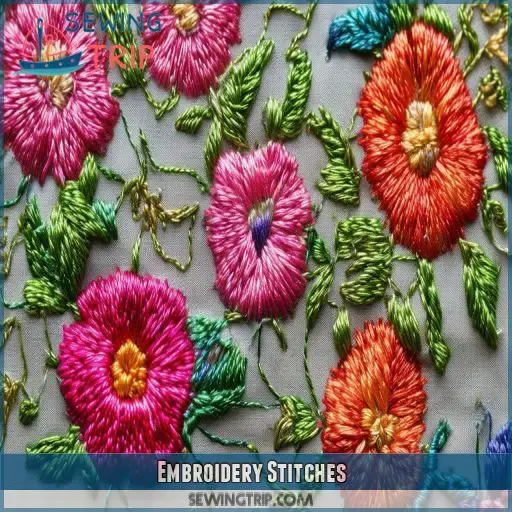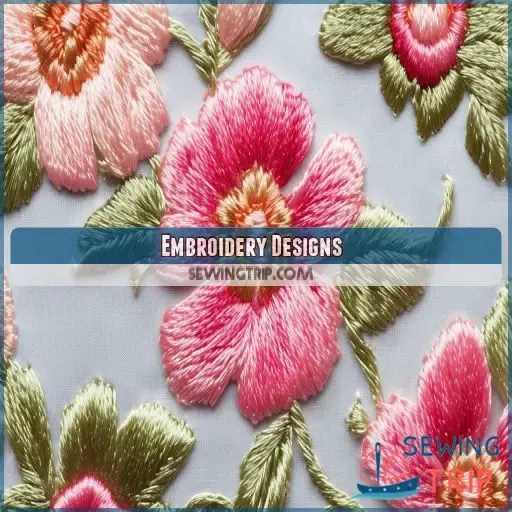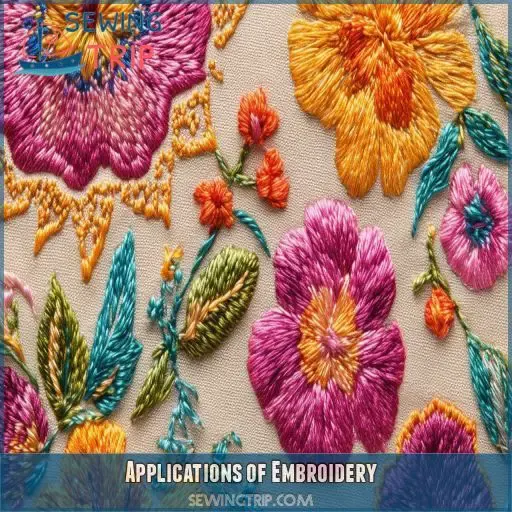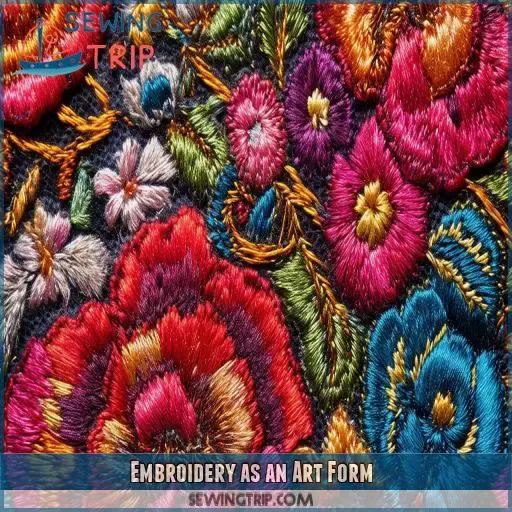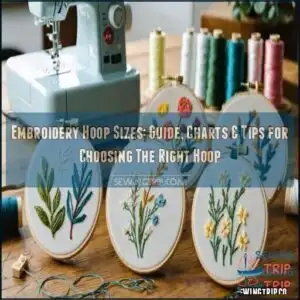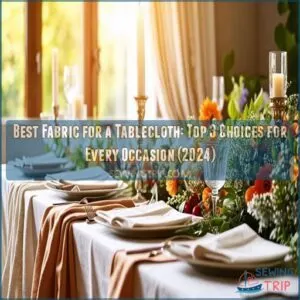This site is supported by our readers. We may earn a commission, at no cost to you, if you purchase through links.
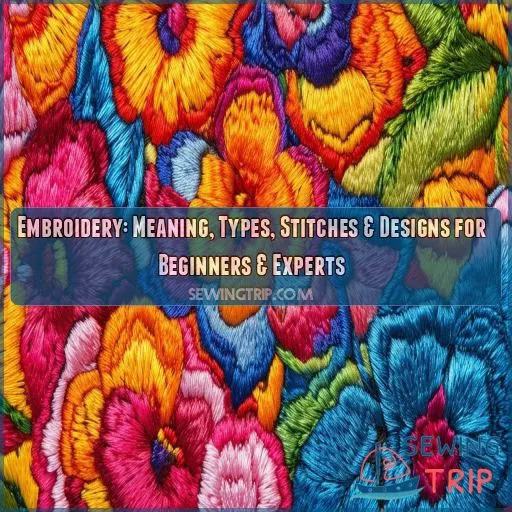 Imagine creating something out of nothing with a needle and thread—this magic is delivered by embroidery. It means to embellish fabric, turning simple cloth into intricate designs.
Imagine creating something out of nothing with a needle and thread—this magic is delivered by embroidery. It means to embellish fabric, turning simple cloth into intricate designs.
Knowing the history, types, stitches, and designs gives one experience at the beginner or advanced learner level in this art.
You will find all kinds of information provided herein, from traditional to the most modern styles, that will help you master this ageless craft and unleash your creativity.
Come along and discover this colorful world called embroidery
Table Of Contents
Key Takeaways
- Embroidery isn’t just your grandma’s hobby! It’s a versatile art form that can turn a plain Jane piece of fabric into a showstopper with just a needle and thread.
- From ancient Egyptian tombs to your favorite pair of jeans, embroidery has been stitching its way through history, leaving a colorful trail of cultural influences and artistic expression.
- Whether you’re a beginner fumbling with a basic running stitch or a pro crafting intricate French knots, there’s a whole world of techniques to explore – it’s like a buffet for your creative appetite!
- Embroidery isn’t just about prettying up pillows (though it’s great for that too). It’s found its way into fashion, home decor, and even fine art – talk about threading the needle between tradition and innovation!
What is Embroidery?
Embroidery is the decorative art of using needle and thread to embellish fabric, creating intricate designs and patterns. Its rich history spans from ancient civilizations to modern times, reflecting diverse cultural traditions and techniques across the world
Definition of Embroidery
Embroidery is the art of decorating fabric using a needle and thread. It’s a versatile craft that can personalize items, making each unique. Embroidery can:
- Showcase cultural influences with unique regional variations.
- Benefit from embroiderers’ guilds for skill development.
- Emphasize ethical sourcing by using sustainable materials
History of Embroidery
Embroidery has a rich history dating back thousands of years with cultural influences, regional diversity, and symbolism.
From ancient Egyptian tomb paintings to Byzantine gold-laden designs and Chinese T’ang dynasty masterpieces, each stitch tells a story.
Over time, technological advancements like embroidery needles and techniques transformed it into both art and craft.
Historical significance remains woven into the fabric of each piece
Types of Embroidery
Embroidery comes in various forms, including hand embroidery, machine embroidery, counted thread embroidery, and free-motion embroidery. Each type offers unique techniques and applications, catering to different skill levels and creative interests
Hand Embroidery
Hand embroidery, rich in history and cultural significance, uses needle and thread to create intricate designs. You can explore various techniques, influenced by regional traditions and materials. From crewel embroidery using wool to surface embroidery on fabric, the art form showcases creativity and craftsmanship.
- Embroidery techniques
- Regional influences
- Cultural significance
- Historical evolution
- Materials and supplies
Machine Embroidery
Now, let’s explore machine embroidery. This method uses embroidery machines, offering:
- Fast and efficient results
- Perfect for mass production and large-scale projects
- Computerized designs for precision
- Diverse embroidery supplies and equipment
- Consistent, high-quality stitching
With machine capabilities, embroidery becomes more accessible, allowing you to quickly and accurately bring your creative visions to life
Counted Thread Embroidery
Like cross-stitch, counted-thread embroidery relies on a precise embroidery chart called a pattern, which requires counting the threads in the fabric to produce the correct stitches and making detailed embroidery designs.
- Embroidery Chart: Patterns with symbols indicating the placement of stitches.
- Fabric Counting: This ensures even spacing and accuracy.
- Design Complexity: It can be simple or detailed.
- Stitch Accuracy: This makes perfect designs.
Free-Motion Embroidery
Free-motion embroidery gives you the freedom to create unique designs by maneuvering fabric under the machine needle without a pattern. It offers:
- Creative expression: Let your imagination soar.
- Flexible designs: No constraints on shapes or patterns.
- Enhanced texture: Add dimension to any piece.
- Innovative techniques: Experiment with stitch variation.
Discover the limitless possibilities of free-motion techniques!
Embroidery Stitches
Embroidery stitches form the foundation of any embroidery project, ranging from basic stitches like the backstitch and cross stitch to more advanced ones such as the feather stitch and chevron stitch. By combining different stitches, you can create intricate designs that add texture and dimension to your work
Basic Stitches
Embroidery stitches form the foundation of your designs and can elevate ordinary fabric into art. Start with basic stitches: the running stitch for outlines, the backstitch for durability, the satin stitch for solid fills, and the chain stitch for decorative loops. These stitches, coupled with varied fabric textures and thread color palettes, create endless design inspiration
Specialty Stitches
Specialty stitches like the French knot, lazy daisy, and herringbone add unique texture and dimension to your embroidery designs. These intricate stitches elevate embroidery embellishment, creating rich texture designs and more sophisticated embroidery patterns. Mastering these embroidery techniques enhances your skill set, allowing for more varied and complex embroidery styles in your projects
Combining Stitches
Combining embroidery stitches allows you to create intricate, eye-catching designs. Pair a classic cross-stitch with a delicate satin stitch for a stunning effect. Machine embroidery makes it easy to efficiently execute complex stitch combinations. Explore contemporary stitch patterns inspired by regional traditions, or follow step-by-step tutorials to master new embroidery techniques. The possibilities are endless when you combine stitches
Embroidery Designs
Embroidery designs range from traditional motifs, often reflecting cultural heritage, to contemporary styles that incorporate modern aesthetics. You can also personalize your embroidery projects, adding a unique touch to clothing, home decor, and gifts
Traditional Designs
Traditional embroidery designs carry rich cultural influence and vary widely by region. Examples include:
- Floral motifs: Often seen in Mughal India and Chinese embroidery history.
- Geometric patterns: Found in Greek island designs and Islamic Persia’s symbolism in designs.
- Historical pieces: The Bayeux Tapestry, showcasing Norman conquest scenes, illustrates historical significance
Contemporary Designs
Contemporary designs in embroidery embrace modern motifs and unique patterns. You’ll find endless possibilities with experimental techniques and digital embroidery.
| Embroidery Trends | Examples |
|---|---|
| Bold Colors | Bright Florals |
| Geometric Patterns | Abstract Shapes |
| Mixed Media | Beads, Sequins |
| Minimalist Designs | Simple Lines |
Personalization
Personalizing your embroidery lets you add a unique touch to your projects. Play with diverse embroidery trends and incorporate regional influences or cultural motifs. Utilize various threads, fabrics, and needles to craft personalized pieces. Modern techniques, like embroidery hoops, elevate your designs, whether for fashion, home decor, or gifts. Your creativity sets your work apart!
Applications of Embroidery
Embroidery finds its way into many areas of daily life, such as fashion and accessories, home decor, and gifts and keepsakes. From adorning clothes with intricate designs to adding a personal touch to household items, you can use embroidery to enhance the beauty and sentimentality of various objects around you
Fashion and Accessories
In fashion and accessories, embroidery displays its uniqueness through regional traditions and cultural symbolism. Give your attire a lift or accessorize in ethnic patterns and their modern interpretations. Reflect on these fashionable uses:
- Embroidered denim jackets
- Intricately stitched handbags
- Scarves, decoratively adorned
- Branded hats with bright designs
Bring timeless craftsmanship into a modern contemporary style.
Home Decor
Embroidery adds elegance and personality to home decor. You can embellish pillows, curtains, and wall hangings with various embroidery designs. Start with the right fabric choice, ensuring it suits your design ideas. Select appropriate threads and use the right hoop type for stability. Whether simple or intricate, choosing the right pattern difficulty will enhance your home’s aesthetic
Gifts and Keepsakes
Embroidery offers thoughtful, meaningful gifts and personalized keepsakes. Items range from commemorative pieces to textile art, reflecting cultural expression. Consider these options:
- Baby Blankets: Personalized with names or birthdates.
- Pillows: Embroidered with special messages.
- Wall Hangings: Custom designs mark life milestones.
- Accessories: Scarves or bags crafted by skilled embroidery artists.
Explore embroidery platforms and marketplaces for unique finds
Embroidery as an Art Form
Within that, as an art form, you get a vibrant tapestry of techniques and influences to look at with embroidery.
Be it traditional cross-stitches or modern digital embroidery, each method speaks for itself.
But it’s how contemporary artists take old and new skills in creating timeless works, showing cheekily just how versatile this craft is.
You’ll find that cultural influences also give their flair—designs vary between an intricate Chinese silk piece or a bold Indian motif.
Today’s world has raised the moot question of textile sustainability, bringing eco-friendliness in materials and practices into center stage.
From a beginner acquainting oneself with basic stitches to a professional trying out intricate designs, there lies broad scope for creativity in embroidery while retaining the umbilical cord with age-old traditions, as well as pushing frontiers in textile art
Frequently Asked Questions (FAQs)
How do you explain embroidery?
You’re creating art on fabric using needle and thread. You’ll stitch designs, patterns, or images onto cloth, bringing it to life. It’s a craft that lets you express yourself while adding beauty to everyday items
What is embroidery vs sewing?
Like Penelope’s patient craft, you’re embroidering when you add decorative stitches to fabric. Sewing, however, is your practical Daedalus, joining pieces together. While both use needle and thread, embroidery beautifies while sewing constructs
What is the purpose of embroidery?
You’ll find embroidery’s purpose is multifaceted. It adorns clothing and home decor, expresses creativity, preserves cultural traditions, and even tells stories. Whether you’re personalizing items or creating art, embroidery adds beauty and meaning to everyday objects
What is embroidery examples?
You’d think embroidery’s just for grandmas, right? Wrong! You’ll find it on your favorite jeans, baseball caps, and even sneakers. It’s everywhere, from elegant wedding dresses to quirky throw pillows. Embroidery’s stitching up the fashion world!
What is the difference between cross stitch and embroidery?
Cross stitch uses X-shaped stitches on a grid, while embroidery encompasses various stitches and techniques. You’ll find cross stitch more structured, but embroidery offers greater freedom in design and creativity. Both can create stunning decorative pieces
What is the easiest way to embroider?
You’ve stumbled upon a great hobby! The easiest way to embroider is to start with simple stitches like the running stitch. Grab a hoop, fabric, and thread, then practice following basic patterns. You’ll be creating beautiful designs in no time!
What is embroidery & how does it work?
Embroidery is a textile art where you decorate fabric with needle and thread. You’ll create patterns by stitching colorful threads onto cloth. It works by passing the needle through the fabric, forming various stitches to build intricate designs
What are the different types of embroidery?
You’ll find various embroidery types to explore. There’s hand embroidery, machine embroidery, counted thread, and surface embroidery. Each offers unique techniques, from cross-stitch to crewelwork. You can even try specialized styles like goldwork or ribbon embroidery
How long does it take to complete an embroidery project?
You’ll find embroidery projects vary widely in time. A simple design might take a few hours, while complex pieces can require weeks or months. Your skill level, available time, and project complexity all influence the duration
Can embroidery be done on leather or synthetic fabrics?
You’re in luck! Embroidery isn’t just for your grandma’s tea towels. You can add your personal touch to leather jackets or synthetic yoga pants. It’s trickier than traditional fabrics, but with the right tools, you’ll master it
Whats the difference between embroidery and needlepoint?
You’ll find embroidery and needlepoint quite different. Embroidery’s versatile, using various stitches on fabric, while needlepoint’s more structured, working tent stitches on canvas. Embroidery’s freeform; needlepoint follows a predetermined pattern. Both create beautiful textile art, though!
How do you transfer patterns onto fabric for embroidery?
Get started in embroidery by convincingly transferring your patterns. All you’ll need is transfer paper, a pencil, and your fabric of choice. Place the paper between the pattern and fabric, then trace. Alternatively, iron-on transfers or water-soluble pens can be used for easy application.
Are there eco-friendly or sustainable options for embroidery materials?
You’ll find eco-friendly embroidery options that’ll satisfy your green thumb. Try organic cotton threads, bamboo hoops, and recycled fabric. You can even use natural dyes from plants. It’s a great way to stitch sustainably!
Conclusion
Did you know that embroidery dates back over 30,000 years?
As you’ve learned, embroidery is a versatile art form with endless possibilities. Whether you’re a beginner or an expert, you now understand what embroidery is, its various types, stitches, and designs.
From fashion to home decor, this timeless craft offers countless applications. By mastering the techniques discussed, you’ll be well-equipped to create stunning embroidered pieces

